Exxon officials say country ‘prepared for the unlikely’
IN a milestone advancement for the oil and gas industry in the region, ExxonMobil Guyana, on Tuesday, commission its newly arrived capping stack at the Guyana Shore Base Inc (GYSBI) in Houston, East Bank Demerara.
This equipment is set to bolster the country’s emergency response and spill containment capabilities, marking a milestone in ExxonMobil’s commitment to safety and environmental stewardship.
During a media event at GYSBI, President of ExxonMobil Guyana Limited, Alistair Routledge said that this is in keeping with the company’s commitment to safety and protection of the environment.
“Day in and day out, our team is laser-focused on preventing incidents of any size from ever happening. However, in the unlikely event of an incident, we have state-of-the-art response capabilities in the country and the financial resources to meet any cleanup requirements,” Routledge said.
The Exxon official pointed that the capping stack is a testament to ExxonMobil’s dedication to maintaining robust in-country technological capabilities.
UNPARALLELED GLOBAL TECHNOLOGY
The newly installed capping stack is a rare and sophisticated piece of equipment, being one of only 13 in existence globally.
It is designed to cap a leaking well by creating a seal, much like a bottle cap, to safely stop the flow of oil until engineers can permanently seal the well.
This equipment can connect to virtually any subsea wellhead in the event that a well’s built-in blowout protector fails, providing an additional layer of safety.
“This is the first capping stack in Guyana and one of only 13 globally. This reflects our commitment to bringing the very highest standards of facilities and equipment to Guyana, given the unique scale of our operation and our partnership with the people of this country.
“ExxonMobil was one of the first global operators to integrate rapid response subsea capping stack technology into our formal global oil spill response planning, so we are very familiar with the technology’s capabilities,” Routledge said.
A COLLABORATIVE EFFORT
Routledge also highlighted the collaborative efforts involved in bringing the capping stack to Guyana.

The Exxon official also thanked the Ministry of Natural Resources, the Environmental Protection Agency (EPA), and the Civil Defence Commission (CDC) for their support.
“Our journey in Guyana has partnership at its core. We are here to collaborate with the government, communities, and local businesses to ensure that the benefits of our operations are widely shared while keeping people safe and protecting the environment,” he said.
ExxonMobil’s commitment to safety extends beyond technology to include rigorous training and preparedness exercises.
Routledge mentioned the recent graduation of the first 24 technicians from the Port Mourant training centre, which simulates an offshore work environment.
This facility is also one of only 13 of its kind globally.
“Moving forward, this new capping stack will become an integral part of our emergency response exercises conducted at the GYSBI Shore Base,” he noted.
SUBSCRIPTION SERVICE FOR REGIONAL SAFETY
The capping stack is part of a subscription service provided by Oil Spill Response Limited (OSRL), where ExxonMobil is the inaugural subscriber.
“It’s our hope that other operators both in Guyana and the neighbouring countries subscribes to this service, because that will truly reflect the benefit of bringing this technology to the region is that all operators drilling wells in this part of the world subscribe to the technology that we have brought into Guyana. We certainly expect never to use this equipment in real life,” the Exxon official said.
Routledge explained, “The more participants we have, the more we can spread the cost…Especially Guyana should worry more about what happens in Suriname,” Routledge explained.
He explained that capping stack will be based at the Vreed-en-Hoop Shorebase, ensuring that it is always prepared for deployment and that we have people prepared and ready to do so.
The arrival of the capping stack is a significant milestone for Guyana, making it the only oil-producing nation in the region with such equipment readily available.
This addition not only meets a condition of ExxonMobil’s Yellowtail production licence but also enhances the country’s ability to mitigate the risk of unplanned hydrocarbon releases into the environment.
With three layers of financial defence amounting to over US$20 billion as of 2023, Guyana remains well-protected from any liabilities should an oil spill occur.
EXEMPLIFYING ENVIRONMENTAL STEWARDSHIP
The new capping stack, designed and built by Trendsetter Engineering and owned by OSRL, is one of only two in Latin America, underscoring its rarity and importance.
Its presence in Guyana exemplifies ExxonMobil’s proactive approach to environmental protection and readiness.
He also expressed gratitude to GYSBI for hosting the event, and for housing essential emergency response equipment.
“GYSBI also houses our containment booms, skimmer devices, dispersants, and numerous other components of the extensive emergency response toolkit that we have placed here since we began our operations,” he added.
“Our first and foremost focus is on preventing any incidents and looking after the environment,” Routledge reaffirmed as he said that Exxon is proud to be at the forefront of bringing such advanced technology and safety measures to Guyana, ensuring that preparation for any eventualities while continuing to protect Guyana’s environment and incredible ecosystem.



.jpg)











